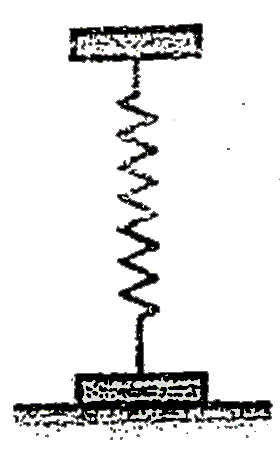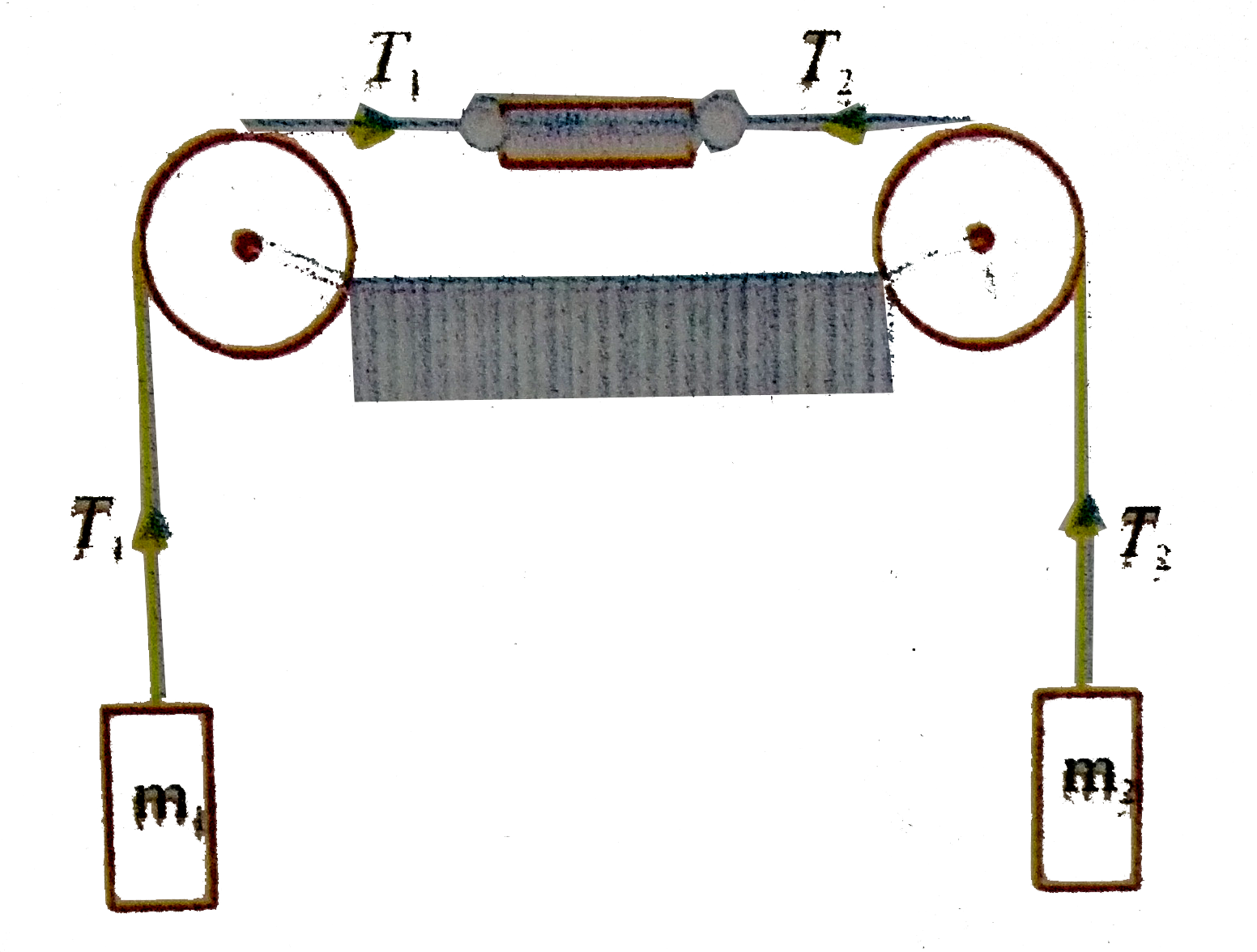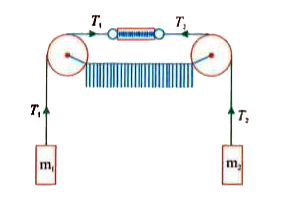Two plates of some mass are attached rigidly to the two ends of a spring as shown in figure. One of the two ends of a spring s shown in figure. One of the plates resets on a horizontal surface to the other rusults a compression y of the spring when it is in equilibrium state. The further minimum compression required, so that when the force causing compression is removed the lower plate is lifted off the surface, will be :

0.5y
3y
2y
y
The correct Answer is:C

Let upper block is pushed down by x, at equilibrium mg=ky, i.e, weight of upper of upper block is balanced by spring When it is deformed bu y, upper block will perform SHM with amplitude x equilibrium position, lower block will leave surface when spring is extended by y, means upper block is at distance 2y from its mean position. That should be upper extreme position of upper block. So amplitude x=2y
Alternate
at equilibrium of upper block mg=ky
lower plate will leave the surface if the extension in spring is y
Let upper plate is displaaced by x downward and left
so by energy conservation between compressed to extended positions
0+12k(x+y)2=mg(x+2y)=12ky2
⇒12kx2+12ky2+kxy=mgx+mg2y+12ky2⇒x=2y
Topper's Solved these Questions
- BOOK - RESONANCECHAPTER - SIMPLE HARMONIC MOTION EXERCISE - Exercise- 2, PART - II1videos
SIMPLE HARMONIC MOTION
- BOOK - RESONANCECHAPTER - SIMPLE HARMONIC MOTION EXERCISE - Exercise- 2, PART - III12videos
SIMPLE HARMONIC MOTION
- BOOK - RESONANCECHAPTER - SIMPLE HARMONIC MOTION EXERCISE - Exercise- 1, PART - II37videos
SIMPLE HARMONIC MOTION
- BOOK - RESONANCECHAPTER - SEMICONDUCTORSEXERCISE - Exercise 388videos
SEMICONDUCTORS
- BOOK - RESONANCECHAPTER - TEST PAPERSEXERCISE - FST-330videos
TEST PAPERS
Similar Questions
Two masses are connected by a spring as shown in the figure. One of the masses was given velocity v = 2 k, as shown in figure where 'k' is the spring constant. Then maximum extension in the spring will be
 View Solution
View SolutionAll surfaces shown in figure are smooth. System is released with the spring unstretched. In equilibrium, compression in the spring will be
 View Solution
View Solution
Knowledge Check
- Question 1 - Select One
Two discs, each having mass m, are attached rigidly to the ends of a vertical spring. One of the discs rests on a horizontal surface and the other produces a compression x0 on the spring when it is in equilibrium. How much further must the spring be compressed so that when the force causing compression is removed, the extension of the spring will be able to lift the lower disc off the table?
 A(a) x0B(b) 2x0C(c) 3x0D(d) 1.5x0
A(a) x0B(b) 2x0C(c) 3x0D(d) 1.5x0 - Question 2 - Select One
Two masses m and 2m are attached to two ends of an ideal spring as shown in figure. When thye spring is in the compressed state, the energy of the spring is 60 J, if the spring is released, then at its natural length
 Aenergy of smaller body will be 20 JBenergy of smaller body will be 40 JCenergy of smaller body will be 10 JDenergy of both the bodies will be same
Aenergy of smaller body will be 20 JBenergy of smaller body will be 40 JCenergy of smaller body will be 10 JDenergy of both the bodies will be same - Question 3 - Select One
Two masses m1 and m2 are attached to a spring balance S as shown in figure. m1>m2 then the reading of spring balance will be .
 .A(m1−m2)B(m1+m2)C2m1m2m1+m2Dm1m2m1+m2
.A(m1−m2)B(m1+m2)C2m1m2m1+m2Dm1m2m1+m2
All surfaces shown in figure are smooth. System is released with the spring instretched. In equilibrium, compression in the spring will be
 View Solution
View SolutionTwo blocks of masses 6 kg and 3 kg are attached to the two ends of a massless spring of spring constant 2π2N/m. If spring is compressed and released on a smooth horizontal surface then find the time period (in seconds) of each block.
View SolutionFind maximum compression is the spring from the given figure.
 View Solution
View SolutionTwo masses m1 and m2 are attached to a spring balance S as shown in Figure. If m1>m2 then the reading of spring balance will be
 View Solution
View SolutionA block of mass m is attached to one end of a mass less spring of spring constant k. the other end of spring is fixed to a wall the block can move on a horizontal rough surface. The coefficient of friction between the block and the surface is μ then the compession of the spring for which maximum extension of the spring becomes half of maximum compression is .
View Solution

